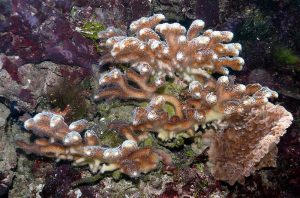15 December 2016
Some corals and scallops better able to handle ocean acidification, study finds
Posted by dgaristo
By Sukee Bennett
Some coral and mollusk species could adjust to acidifying ocean waters better than previously thought, according to new research. In a study presented at the 2016 American Geophysical Union Fall Meeting, researchers showed that warming ocean temperatures and increased carbon dioxide concentrations failed to slow down the process of building shells, known as calcification, in the branching coral species Stylophora pistillata and the Atlantic great scallop, Pecten maximus.
Global climate change has a large influence on the ocean and the organisms that dwell within it. The majority of shelled marine organisms scientists have previously studied struggle to calcify in seas heavily affected by climate change and ocean acidification. But the researchers involved in the new study have found Stylophora coral and the great scallop to be hardy and hopeful exceptions to the typical trend.
Due to its ability to collect and hold onto excess carbon dioxide in the air, the planet’s greatest carbon sink—the ocean—is becoming warmer and more acidic. When it mixes with seawater, carbon dioxide becomes carbonic acid, lowering the pH of the ocean. Scientists suspect that under more acidic conditions, marine invertebrates such as corals and mollusks will struggle to build and maintain their calcium carbonate shells. Assembling shells requires water to be slightly basic. And like chalk, which is also calcium carbonate, these calcium shells can fizzle away in acidic water over time.
Corals and mollusks modify the fluid inside themselves to turn calcium in the surrounding water into hard shells and skeletons. Previous research has shown that corals increase and regulate their fluid’s pH so that it’s approximately 0.5 pH units higher than the pH of the surrounding water, an increase from 8.4 to as high as 8.9, said Louise Cameron, a PhD candidate at Northeastern University and lead author of the new study. But mollusk calcification strategies and the effects of rising ocean acidity on coral and mollusk calcification have remained a mystery.
In the new study, Cameron and her team exposed great scallops and Stylophora corals to various temperatures and acid concentrations in controlled tanks to see how these factors influenced the organisms’ abilities to calcify.
They bubbled carbon dioxide into each tank until the concentration reached 400 parts per million, the approximate global average of atmospheric carbon dioxide. They then stabilized the water temperature at 28 degrees Celsius (82 degrees Fahrenheit) in all tanks, the temperature corals and scallops are normally exposed to.
After allowing the corals and scallops to acclimate for a week, the researchers slowly increased the temperature and carbon dioxide levels in some of the tanks to those projected for the end of the century. In some tanks, they raised carbon dioxide levels far beyond projected levels to see if the coral and mollusk’s response leveled out, Cameron said.
“By pushing an organism to its limits, it can also make it easier to uncover the mechanisms behind the response you’re seeing,” she said.
The corals and scallops sat in their respective tanks for a month, long enough to acclimate and start calcifying. Then Cameron and her team drilled a tiny hole through each scallop’s shell to sample their calcification fluid contents and pH. Because corals lack an external shell, the research team used tiny glass capillaries called microelectrodes that they repeatedly heated and pulled until the tips were only one thousandth of a millimeter thick—fine enough to insert painlessly into coral tissue—to study the fluid within.

Stylophora pistillata corals. New research shows these corals and some mollusk species are adjusting to acidifying ocean waters better than previously thought.
Credit: Haplochromis via Wikimedia Commons.
The team found the process of mollusk calcification to be quite different from coral calcification. Stylophora corals exposed to higher temperatures and more carbon dioxide amped up their calcification efforts and continued to increase their internal pH. But the great scallops never increased their fluid’s pH during the calcification process. In some cases, their fluid was even more acidic than the seawater they were bathed in, but they were still able to calcify at a rate comparable to that in cooler, more basic conditions.
The explanation? Unlike the corals’ fluid, the mollusks’ was filled with organic matter, Cameron found. The scallops fostered a myriad of proteins, like chitin, that work like building blocks. She suspects these proteins offer their mollusk hosts a helping hand when calcifying.
While both Stylophora corals and scallops appear resistant to warming and carbon dioxide rich waters in the study, the scallops are still susceptible to degradation, Cameron said. There’s a chance their calcification rates, which remained the same in normal and acidic conditions, may not be speedy enough to repair shells corroded by acidic waters. And scientists still worry that other marine species may not endure, Cameron said.
“These corals are resistant, but it’s not beneficial to have just one particular species,” said Gianna Pantaleo, a researcher at the University of California, Santa Cruz, who conducted similar research on Stylophora from the Red Sea. Each species plays an important and unique role in the marine ecosystem, she said: to lose one ocean species may mean losing a myriad of others.
—Sukee Bennett is a science communication graduate student at the University of California Santa Cruz. Follow her on Twitter at @Sukee_B.



 GeoSpace is a blog on Earth and space science, managed by AGU’s Public Information staff. The blog features posts by AGU writers and guest contributors on all sorts of relevant science topics, but with a focus on new research and geo and space sciences-related stories that are currently in the news.
GeoSpace is a blog on Earth and space science, managed by AGU’s Public Information staff. The blog features posts by AGU writers and guest contributors on all sorts of relevant science topics, but with a focus on new research and geo and space sciences-related stories that are currently in the news.